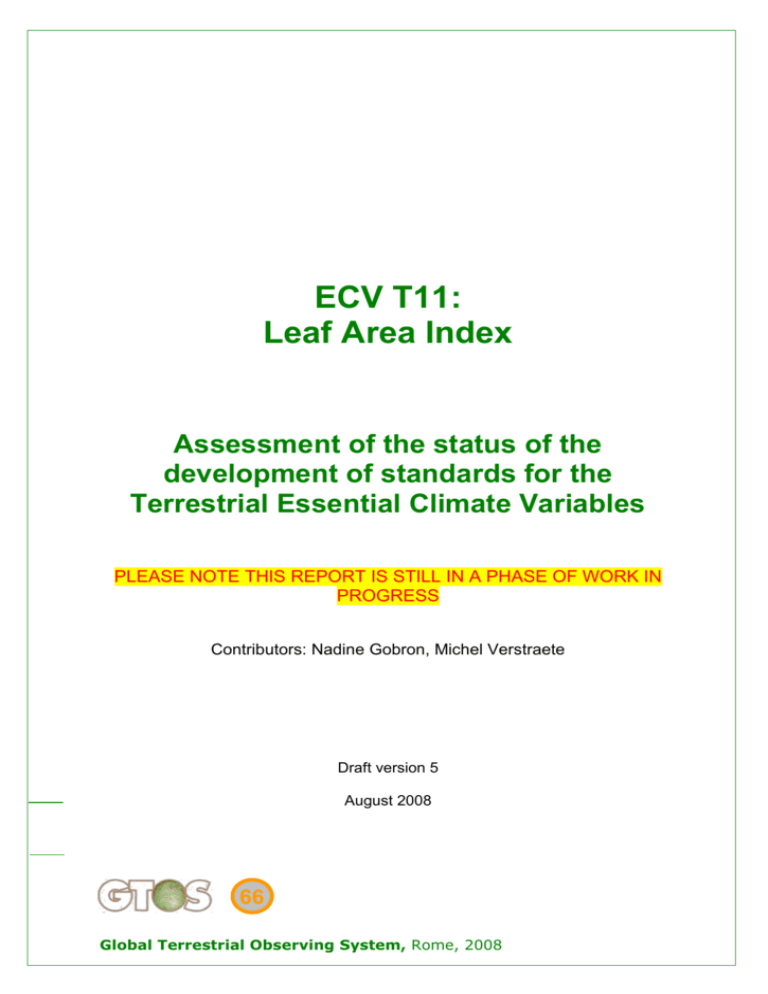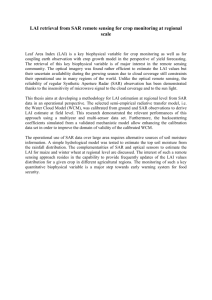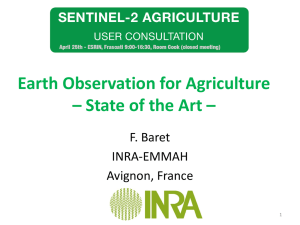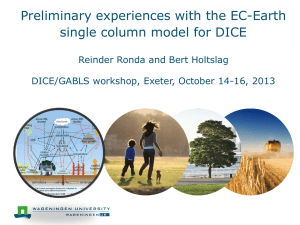Permafrost Summary - Food and Agriculture Organization of the
advertisement

ECV T11: Leaf Area Index Assessment of the status of the development of standards for the Terrestrial Essential Climate Variables PLEASE NOTE THIS REPORT IS STILL IN A PHASE OF WORK IN PROGRESS Contributors: Nadine Gobron, Michel Verstraete Draft version 5 August 2008 66 Global Terrestrial Observing System, Rome, 2008 T11 ECV T11: Assessment of Standards for LAI Contents Acronyms .................................................................................................................................. 3 Executive Summary .............................................................................................................. 4 1. Introduction ........................................................................................................................ 6 2. Definition and units of measure ................................................................................. 6 3. Existing measurements methods protocols and standards ............................. 7 3.1 In situ measurements .............................................................................................. 7 3.2 Satellite Observations .............................................................................................. 8 3.3 Intercomparison and validation ......................................................................... 10 3.4 Summary of requirements and gaps ............................................................... 11 4. Contributing networks and agencies ...................................................................... 11 5. Available data .................................................................................................................. 12 5.1 In Situ .......................................................................................................................... 12 5.2 Satellite........................................................................................................................ 12 6. Other issues ..................................................................................................................... 13 7. Conclusions ....................................................................................................................... 14 8. Recommendations ......................................................................................................... 14 8.1 Standards and methods ........................................................................................ 15 8.2 Other recommendations ....................................................................................... 15 9. References ........................................................................................................................ 16 2 T11 ECV T11: Assessment of Standards for LAI Acronyms ASDC BGC CALVAL CEOS CNES EC-JRC ECVs EOS ESA FAPAR FVC GEM IES INRA IVOS JRC LAI LP DAAC LPV LSA SAF LUT MOD12Q1 MODAGAGG NASA R&D RAMI RAMI RT? TEMS TIP? TRAC VITO WGCV Atmospheric Science Data Center BioGeochemical Cycles CALibration VALidation? Committee for Earth Observation Satellite Centre National d’Etudes Spatiales European Commission - Joint Research Center EC-JRC Essential Climate Variables Earth Observing System? European Space Agency Fraction of Absorbed Photosynthetically Active Radiation Fractional Vegetation Cover Global Environment Monitoring Institute for Environment and Sustainability Institut National de la Recherche Agronomique Infrared and Visible Optical Sensors Joint Research Center Leaf Area Index Land Processes Distributed Active Archive Center Land Product Validation Land Surface Analysis Satellite Applications Facility Look-Up Table MODIS Land Cover Product MODIS Surface Reflectance Product National Aeronautics and Space Administration Research and Development RAdiation transfer Model Intercomparison? Reliability, Availability, Maintainability and Inspectability? Terrestrial Ecosystem Monitoring Sites Tactical Radar Analysis Center? Flemish Institute for Technological Research Working Group on Calibration and Validation 3 T11 ECV T11: Assessment of Standards for LAI Executive Summary The Leaf Area Index (LAI) of a plant canopy is a quantitative measure of the amount of live green leaf material present in the canopy per unit ground surface. Specifically, it is defined as the total one-sided area of all leaves in the canopy within a defined region, and is a non dimensional quantity, although units of m2/m2 are often quoted, as a reminder of its meaning. This concept is largely used in agro-meteorology, but many atmospheric general circulation or biogeochemical models also rely on it to parameterize the vegetation cover, or its interactions with the atmosphere. For instance, evapotranspiration and carbon fluxes between the biosphere and the atmosphere are routinely expressed in terms of the LAI of the canopy. Monitoring the distribution and changes of LAI is therefore important for assessing the state and evolution of the vegetation on the planet. Multiple methods (including direct harvesting—a destructive method, or indirect radiation measurements such as hemispherical photography and observations of light transmission through the canopy) have been proposed to estimate LAI on the ground or remotely, and in each case different researchers tend to follow their own (non-standardized) protocols. Space agencies and other institutional providers generate maps of LAI at various spatial resolutions for daily to monthly periods, over the globe, using mainly optical space borne sensors. In this case, the values actually delivered correspond to an allometric or an effective value that depends on the spatial resolution of observations. LAI values are occasionally estimated locally through ground-based measurements, for instance at several validation sites spanning a range of land cover types. These validation exercises are performed in the framework of ground-based networks, including both national research groups and international entities, such as the Land Product Validation (LPV) Subgroup of the CEOS Working Group on Calibration and Validation (CEOS-WGCV). The main validation efforts concentrate on improving the reliability and accuracy of the ground-based estimates by defining state of the art protocols suitable to address the very different spatial dimensions of in situ and remote sensing measurements. The Terrestrial Ecosystem Monitoring Sites (TEMS) database documents research sites and the observations they are undertaking including in situ information on LAI values (www.fao.org/gtos/tems/). For example, LAI is a standard parameter observed at all FLUXNET sites. A community effort is on going to define procedures and methods to guarantee the compatibility between the assumptions made while retrieving remote sensing products and those inherent to the applications models as well as ground-based estimates. 4 T11 ECV T11: Assessment of Standards for LAI Recommendations LAI products have proved very useful in a number of environmental applications, including estimating carbon assimilation by plants. Long-time series of accurate and precise LAI products derived from space are essential for climate change studies, especially at regional and local scale, to improve the parameterization of the surface-atmosphere interaction processes in a range of models. Further investigations are underway to document climate changes and their impacts on the land surface, and these will also require access to long time series of accurate products derived from historical data archives. This, in turn, will necessitate the reprocessing of existing database to generate the most extensive and accurate records. Given the usefulness of existing LAI products for this and other applications, it will also be critical to ensure the continued availability of this product in the foreseeable future, on a global scale, at a high temporal resolution, and with a clear characterization of the associated measurement uncertainties. Advances in sensor design, including multi-angular instruments, and updated retrieval procedures are expected to better characterize and further reduce the uncertainties associated with this product, as is required for the implementation of new land surfaces data assimilation systems in Global Climate Models. Validation campaigns should be scheduled over selected sites, distributed globally to sample a large number of land terrestrial surface types. These networks must ensure the standardization of measurements, their optimal spatial distribution, as well as the benchmarking of the acquisition protocols. The conversion of field measurements to effective values, an essential step when trying to estimate this variable from optical remote sensing observations, requires additional information about the structure and architecture of the canopy, e.g. gap size distributions, at the appropriate spatial resolutions. The consistency between this LAI, a state variable, and the FAPAR (ECV T10), a radiation flux, is important and must be guaranteed. 5 T11 ECV T11: Assessment of Standards for LAI 1. Introduction A wide range of models (used in agriculture, ecology, carbon cycling, climate and other studies) require information on the amount of leaf material present in a given environment to correctly represent radiation, heat, momentum, water, and various gas exchanges with the overlying atmosphere or the underlying soil (Monteith and Unsworth, 1990). The Leaf Area Index (LAI) thus often features as a critical state variable in these models. The LAI [m2/m2] is geometrically defined as the total one-sided area of photosynthetic tissue per unit ground surface area. The main uses of LAI are in soil-vegetation-atmosphere models, BioGeochemical Cycles (BGC) models, agro-meteorology for crop assessment, which often require long time series at various temporal and spatial scales. LAI can be measured in situ or estimated remotely, using direct or indirect methods. In the latter case, physically-based algorithms are nowadays exploited to guarantee the accuracy of the products, and the retrieved values of LAI correspond to allometric or effective estimates that depend on the spatial resolution of the remote observations. Operational remotely sensed LAI products are mostly derived from mediumresolution optical sensors (e.g., MODIS and MISR). These are available at a variety of spatial (from one kilometer to half degrees) and temporal (from daily to monthly) resolutions. In addition, various national and international projects, like GLOBCARBON and LANDSAF, to name but a few, provide additional collections of products using data streams derived from other sensors (such ATSR, VEGETATION or SEVIRI) over up to several years, at the continental or global scale. The uncertainties associated with indirect retrieval method are larger for higher values of the variable: this is because LAI plays the role of the optical thickness state variable in the radiation transfer theory: this parameter can be reliably retrieved only if light actually reaches the lower boundary condition (i.e., the soil) and is scattered back to the sensor in measurable amount. This also implies that the currently available retrieved products depend on the performance of the RT model used in the inversion. LAI products derived from remote sensing products must be considered as ‘effective’ values, which should always be interpreted taking into account the model used for the retrieval, assumed boundary conditions, and the possible influence of 3D structural effects, especially at high spatial resolution. Benchmarking and comparing these LAI products is essential to document the accuracy of available space-derived products, while ground-based networks, coordinated by CEOS-WGCV, perform measurements relevant for validation exercises. 2. Definition and units of measure 6 T11 ECV T11: Assessment of Standards for LAI LAI measures the amount of leaf material in an ecosystem It is geometrically defined as the total one-sided area of photosynthetic tissue per unit ground surface area. For non-leaves vegetation types, such as needles trees, other definitions may be slightly different and can be expressed as the total foliage surface area per unit of horizontally projected ground surface area. However, for the CEOS LAI Intercomparison, needle leaf area is taken to be half of the total foliage surface area. This definition has been adopted because it conforms to the reference “ground truth” LAI measured by optical instruments such as LAI-2000 and TRAC, which are the most commonly used validation instruments (Morisette et al, 2006). However, the definition of LAI used in space remote sensing science is linked to the state variable corresponding to the canopy optical depth measured along the vertical. When LAI is retrieved from remote sensing measurements, by inverting a radiation transfer model, its value corresponds to an effective value linked to the particular spatial resolution of those measurements. The conversion of geometrical measurements to effective values becomes an essential step and requires additional information about the structure and architecture of the canopy, e.g. gap size distributions, at the appropriate spatial resolutions. 3. Existing measurements methods protocols and standards The accurate estimation of LAI interests various segments of the scientific community. LAI is traditionally measured in the field by destructive methods: the vegetation of a given area is completely defoliated, and the surface of each and every leaf is measured. This relatively exact but labor-intensive approach is practicable only on limited experimental plots and for relatively small plants. More practical approaches are required for routine estimations in a wide variety of biomes. An empirical relation between the amount of leaf material in a canopy layer and the transmission of direct solar radiation through that layer has been established by Monsi and Saeki (1953) and has served to indirectly estimate LAI by photographic or radiometric methods. Dedicated field instruments are now available that implement these techniques. Nevertheless, all these methods provide necessarily local estimations, and the intrinsic variability of the plant cover at all scales from the plant to the biome make it difficult to assess the appropriate value of LAI over large areas on the basis of a few point measurements. There is therefore a strong motivation to try to estimate this environmental parameter using remote sensing techniques, which could much more effectively provide information on the broad spatial and temporal distribution of LAI. 3.1 In situ measurements LAI can be estimated in situ using commercially available LAI meters. Around 183 sites have been referenced in TEMS, including those of FLUXNET and CARBOEUROPE-IP, as well as various national programs. 7 T11 ECV T11: Assessment of Standards for LAI LAI, as well as other related ECVs (FAPAR, biomass, and surface albedo) is much harder to measure in tall (and especially heterogeneous) forest environments than for crops or grasslands. Only a small subset of all existing land cover types has been adequately characterized (and then only in a few climatic zones). No universal standard has been clearly defined yet regarding the procedure to measure LAI. Direct and indirect in situ LAI measurements methods (Jonckheere et al., 2004 and Breda, 2003) have both been deployed. Direct methods are intensive, can be used in a limited way and consist of leaf collection (e.g., harvesting method or leaf litter collection during leaf- fall season), followed by leaf area measurement (using planimetric or gravimetric methods). Indirect methods exploit remote observations of a proxy variable. They are generally faster, amendable to automation, allow for a larger spatial sample to be measured and are becoming the primary approach (allometric techniques; inclined point quadrat; transmission techniques; hemispherical cameras), especially to survey large areas. The various in situ LAI methods and the results obtained have been described in the peer-reviewed literature, and various intercomparison tests have been performed. Individual methods each have their specific strengths and weaknesses, and may be more or less applicable than others depending on the local circumstances. A general consensus appears to exist on the usefulness and applicability of the various approaches, and no standards have been defined or generally accepted yet; however, common guidelines have often been developed and used by research teams collaborating in larger research programs in various countries. 3.2 Satellite Observations A satellite-based estimation of LAI is an indirect approach, relying on the relationship between LAI and the characteristics of the solar radiation reflected from the canopy, as measured by an optical sensor. Besides the process of light interaction within the canopy, the satellite data are affected by the intervening atmosphere, the characteristics and performance of the sensor, and the processing of the received signal. A physically-based approach is required to properly interpret these measurements, and is nowadays the main methodology to retrieve LAI products. Additional details on the methodologies followed to derive current products are summarized below: NASA LAI MODIS: The MODIS LAI/FPAR algorithm consists of a main procedure that exploits the spectral information content of MODIS surface reflectances at up to 7 spectral bands. A three dimensional formulation of the LAI/FPAR 8 T11 ECV T11: Assessment of Standards for LAI inverse problem underlies this procedure. Should the main algorithm fail, a back-up algorithm is triggered to estimate LAI and FAPAR using vegetation indices. The algorithm requires a land cover classification and is therefore linked to the MODIS Surface Reflectance Product (MODAGAGG) and the MODIS Land Cover Product (MOD12Q1) (Knyazihin et al 1998b; Myneni et al. 2003). MISR: A Look-Up Table (LUT) approach is used to rapidly model the radiative transfer process of complex canopy/soil models and then determine the matching modeled reflectances and the associated values of LAI and FAPAR. For efficiency in execution of the algorithm, all necessary radiative transfer parameters have been pre-computed and stored in the Canopy Architecture Radiative Transfer (CART) file (Knyazihin et al. 1998a; Hu et al. 2003, 2007). GLOBCARBON LAI and instantaneous FAPAR are derived using a constrained model-based Look-Up Table (LUT) as described in Deng et al. (2006). This relies on relationships between LAI and reflectances of various spectral bands (red, near-infrared, and shortwave infrared) (Plummer et al. 2007). These relationships have been established for different types of vegetation types, using a physically-based geometrical model complete with a multiple scattering scheme (denoted Four-Scale by Chen and Leblanc, 2001). CYCLOPES The algorithm is based on a neural network approach trained over radiative transfer model simulations. The retrieval is applied on top of canopy reflectances after smoothing the CNES SPOT-VEGETATION data to eliminate outliers (Baret et al, 2007). LANDSAF The algorithm currently operational for retrieving LAI at the LSA SAF is the backup solution of a physical-model inversion method (Garcia-Haro et al., 2006). This backup algorithm employs a semi-empirical exponential relationship with the Fractional Vegetation Cover (FVC) product as in Roujean and Lacaze (2002). The algorithm assumes spherical orientation of the foliage and a coefficient which is a function of the leaf albedo. Although this relationship is unique for each biome, the coefficients can be empirically fitted to different vegetation types. A random distribution of the vegetation is assumed, which leads to an under-estimated effective LAI in highly clumped vegetation, such as boreal or tropical forest. However, the algorithm allows incorporating a clumping index to adjust for clumping effects on LAI estimates. The overall LAI error is computed by propagation of the input error (http://landsaf.meteo.pt). JRC-TIP 9 T11 ECV T11: Assessment of Standards for LAI The main goal of this approach is to help bridge the gap between available remote sensing products and large-scale global climate models. To ensure consistency between various surfaces fluxes and to facilitate the assimilation of space remote sensing products in these models, Pinty et al (2007, 2008) recently proposed an advanced methodology that capitalizes on automatic differentiation techniques to generate the Adjoint and Hessian codes of a cost function. This software package, called JRC-TIP, inverts the two-stream model of Pinty et al. (2006) in a numerically accurate and computer efficient manner. It delivers extensive statistical information on the results, allowing the user to evaluate in quantitative terms the quality of the retrievals and the performance of the inverse procedure itself. 3.3 Intercomparison and validation Measurements of LAI (and other ECVs) are required to support long-term global climate investigations for two reasons. One is to ensure that all key biomes are properly and consistently sampled. This will allow the details of natural vegetation changes and carbon stocks to be carefully monitored in key locations. The other is to generate the field data required for validation of satellite-based measurements, thereby enabling the calculation of these variables on a global scale. Comparing remote sensing products retrieved at medium spatial resolutions (spatial sampling frequency of about 1 km or more) with in situ measurements implies addressing a number of issues and trade-offs. For instance, the uncertainty in the exact location of particular pixel coordinates on the Earth geoid when remapped, suggests averaging the values over an area containing multiple pixels to ensure that the resulting time series relates to a relatively clearly defined geophysical system. For their part, the protocols for acquiring local ground measurements must be conceived so as to minimize undesirable effects related to the different spatial resolutions between the retrieved remote sensing products and the ground-based measurements. Specifically, ground measurements should optimally take into account the three-dimensional (3-D) spatial variability of the canopy attributes, and in particular estimate the radiant fluxes existing inside the (relatively low resolution) sampled domain (Knyazihin et al, 1997, Widlowski et al. (2006, 2008)). No comprehensive intercomparison of ALL available and current LAI products (described above) has been published yet. Such an evaluation might be very difficult to accomplish because existing products diverge as far as timecompositing period and retrieval algorithm, spatial resolution as well as remapping techniques. In any case, future inter-comparisons should be carried out, using products at the closest to the native spatial and temporal resolution of the sensors (i.e. ~ 1 km), on time periods long enough to document the inter-annual variability of vegetation. Morisette et al. (2006) reviewed the techniques employed in various countries to produce LAI from ground-based measurements in order to evaluate mediumcoarse products. They also identified the required elements for an international satellite-based products validation effort: an organizational entity, the willingness of participants to improve the consistency between methods and results, a mechanism for sharing the data, along with a description of the procedure used, and the synthesis of data and results into global accuracy statements. The Land 10 T11 ECV T11: Assessment of Standards for LAI Product Validation Subgroup of the CEOS Working Group on Calibration and Validation is leading this activity which is supported by CEOS member agencies. 3.4 Summary of requirements and gaps Different LAI products are retrieved under various assumptions and depend on the sensor resolution. This has hindered their validation and comparisons. These products are also derived using different radiation transfer models, which is perfectly acceptable provided those models are themselves carefully benchmarked, for instance in the context of RAdiation transfer Model Intercomparison (RAMI) See http://rami-benchmark.jrc.ec.europa.eu/HTML/Home.php. Access to daily products at the sensors’ native spatial and temporal resolution is essential for comparisons purposes on validation sites (prior to applying time-composite or remapping technique). In-situ LAI datasets should be provided with detailed information on the spectral and architectural properties of the targets of interest, to help properly interpret the ground-based measurements. 4. Contributing networks and agencies The GLOBCARBON project is funded by ESA and includes external partners such as Flemish Institute for Technological Research (VITO) and the SPOT VEGETATION program of CNES. NASA funds the MODIS and MISR instruments and ground segments, FAPAR products are available through the land processes distributed active archive Center (LP DAAC) and Atmospheric Science Data Center (ASDC), respectively. CYCLOPES was a European Union FP-5 project, which also benefited from additional funding from CNES, Région Midi-Pyrénées, and Réseau Terre et Espace. Coordinated by INRA Avignon, CYCLOPES is operated in the framework of the POSTEL Thematic Centre. LANDSAF: The scope of Land Surface Analysis Satellite Applications Facility (LSA SAF) is to generate and distribute land surface products derived from the Meteosat families of satellites (MSG and EPS) of EUMETSAT. The Global Environment Monitoring (GEM) unit of the Institute for Environment and Sustainability (IES) of the European Commission - Joint Research Center (ECJRC) designs and publishes protocols for validation of remote sensing products as well as radiation transfer models. 11 T11 ECV T11: Assessment of Standards for LAI 5. Available data 5.1 In Situ LAI are typically measured at ecological and carbon cycling research sites operating a flux tower (http://www.fluxnet.ornl.gov/fluxnet/index.cfm; http://www.carboeurope.org/). LAI measurements are sometimes repetitively acquired at specified locations with LAI-2000 and TRAC instruments to document temporal changes, but are also derived locally with direct (destructive, hence nonreproducible) measurements. Turner et al. (2005) and others used higher resolution space-based sensors (like LANDSAT) to up-scale ground-based measurements (mainly LAI) at up to ~ 1 km resolution. Table 1: Examples of LAI ground-based datasets available for the validation of products and approaches. Field Experiments Summary of the approach for domain-averaged References <LAI> estimations Dahra and Tessekre (Senegal) 2000-2001 BigFoot (Sevilleta, Bondville etc …) 20002002 Safari (Mongu) 2000-2002 <LAI> derived from PCA-LICOR Fensholt et al. [2004]. <LAI> derived from specific leaf area data and Turner et al. harvested above ground biomass; advanced [2005] procedure to account for spatiotemporal changes of local LAI LAI-2000 plant canopy analyzer, Huemmrich et al. [2005] 5.2 Satellite Table 2 summarizes the characteristics of LAI products generated by the main data providers on the basis of medium resolution optical spectral observations. The MISR instrument on NASA's Terra platform has already exceeded its design lifetime, though it may be operated for a few more years. In the case of MODIS, two sensors have been deployed, on the Terra and Aqua platforms. Both will also be phased out at some future point. The MERIS instrument on board ESA's ENVISAT platform is expected to be operated beyond 2010. LAI products can thus in principle be offered for the period from the beginning of 1998 until at least 2010. 12 T11 ECV T11: Assessment of Standards for LAI Table 2: Actual Products availability and access links of main products providers Sensor MODIS Terra (Aqua) MISR ATSR/VGT Spatial/Temp oral Resolution 1 km to 0.25° Dates range Products access Jan. 2000 http://edcdaac.usgs.gov/ (June Daily;8-day 2002) to and monthly end of mission 1.1 km to 0.5° Jan. 2000 http://eosweb.larc.nasa.gov/ to end of Daily, monthly, mission seasonal and yearly products 1km;10km; 1998-2006 http://geofront.vgt.vito.be 0.25°, 0.5° Reference Knyazikhin et al. (1998b) Knyazikhin et al. (1998a) Plummer et al. (2006) Daily 6. Other issues While currently operating sensors on environmental platforms (MODIS, MISR, MERIS, etc) appear to be working adequately well beyond their design lifetime, there may be a gap in data acquisition if these fail before the next generation of instruments (e.g., NPOESS, SENTINEL-2 and 3) becomes operational. In the mean time, it would be useful to define and widely implement protocols on how to acquire field measurements so that the data sets acquired can be readily exploited for the validation of remote sensing products. Issues that need more attention include the spatial sampling (to address the difference between local point measurements with area averages of satellite products, or to address 3-D canopy structure issues, especially in the case of high spatial resolution sensors). Open access to the products at their native spatial resolution and information on their accuracies are essential to ensure their validation. The CEOS-CALVAL working group seems to be the appropriate entity to address this issue. Validation programs have to be prepared and scheduled in advance of the launch of future sensors, as was done with the EOS validation program for the instruments on the NASA TERRA platform. 13 T11 ECV T11: Assessment of Standards for LAI 7. Conclusions No standard method has been internationally agreed upon to estimate LAI from satellite remote sensing observations yet, though most product providers have moved to physically-based approaches. Various experimental LAI products have been generated from satellite data sources, and validation as well as inter-comparisons of these products have been initiated, using ad hoc experimental protocols; such activities could be usefully combined with those focused on the FAPAR. Due to the spatial and temporal variability of LAI, the information required for climate change purposes can only be obtained through measurements by satellite optical sensors. Experience accumulated over the last decade shows that sensors featuring at least one spectral band in the blue domain (in addition to the usual red and near-infrared) yield much higher quality products because they allow for more accurate atmospheric corrections. Further R&D activities are on-going to adapt current methods to the specifications of future sensors, and to develop methodological frameworks capable of delivering not only suites of internally consistent and compatible products, but also precise characterizations of the uncertainties associated with these products. This is essential to foster the exploitation of remote sensing products using assimilation techniques. Significant efforts should be made to ensure the consistency of the various radiant energy fluxes (e.g. surface albedo, transmittance, LAI and FAPAR) derived from remote sensing observations, and their compatibility with the specific requirements of the models, especially in the context of data assimilation systems. 8. Recommendations The systematic application of inter-comparisons of satellite-based LAI products should continue to be strongly supported, including the long-term collection of LAI measurements at sites that represent the variety of vegetation canopies around the globe (with particular attention to the tropics, where satellite-based methods are hampered by persistent cloudiness). The establishment of consensus guidelines for LAI in situ measurements should be undertaken, with emphasis on common methodologies. Different methods exist and have their own advantages and drawback, but more effort should be placed on facilitating inter-comparisons between sites. R&D efforts are urgently needed to further develop the tools and procedures needed to upscale field measurements to remote sensing observations. Support will also be required to develop a broad consensus on best practices. All future space-based sensors intended to generate biogeophysical products to monitor or characterize terrestrial environments should be designed to include one or more spectral bands in the blue region as well as multiangular capability, to 14 T11 ECV T11: Assessment of Standards for LAI improve the efficiency of the atmospheric corrections algorithms and the characterization of canopy structure, respectively. Networks of ground-based measurements for the routine acquisition of relevant observations, in particular over sub-sampled geographical regions should be promoted. These networks must ensure that observations follow well-defined protocols that recognize the existence of different radiation transfer regimes (such as those prevailing in forested versus agricultural environments). The main difficulty here is to correctly sample of the ecosystems exhibiting very high spatial variability at scales that matter for medium resolution sensors. Finally, research and developments efforts should focus on improving the reliability and accuracy of these products to facilitate their ingestion by data assimilation systems. This will, in turn, lead to a better understanding of the climate system and may improve weather forecasts as well. This leads, for example, to a major effort for assessing the consistency of various radiant energy fluxes (e.g. surface albedo, transmittance and FAPAR) between current observations together with the models. 8.1 Standards and methods LAI products should be provided with detailed information on the spectral and architectural properties of the targets of interest, to help properly interpret the ground-based measurements. Protocols for validation should indicate the type of vegetation radiation transfer regime applicable, as well as the ambient conditions prevailing at the time of the in situ measurements 8.2 Other recommendations Space agencies and data providers should ensure that when a RT model is used in the operational retrieval of LAI and other vegetation canopy properties, these models undergo exhaustive testing and benchmarking, for instance by participating in RAMI (Widlowski et al., 2007). Free access to daily products at the sensors’ native spatial and temporal resolution is essential for comparisons purposes on validation sites (prior to applying time-composite or remapping algorithms). Time series of ground-based estimates are more informative than isolated measurements. Currently the CALVAL portal is only dedicated to calibration of Infrared and Visible Optical Sensors (IVOS). It should be extended to validation of ECVs. 15 T11 ECV T11: Assessment of Standards for LAI 9. References Baret F. et al. 2007, ‘LAI, fAPAR and fCover CYCLOPES global products derived from VEGETATION: Part 1: Principles of the algorithm’ Remote Sensing of Environment’, Volume 110, Issue 3, 275-286 Breda, N.J. 2003, ‘Ground-based measurements of leaf area index: a review of methods, instruments and current controversies’, Journal of Experimental Botany 54: 2403-2417. Chen, J.M. & J. Cihlar 1999, ‘BOREAS RSS-07 Regional LAI and FPAR Images From Ten-Day AVHRR-LAC Composites. Data set’ Available on-line [http://www.daac.ornl.gov] from Oak Ridge National Laboratory Distributed Active Archive Center, Oak Ridge, Tennessee, U.S.A Chen, J. M., Pavlic, G., Brown, L., Cihlar, J., Leblanc, S. G., White, H. P., Hall, R. J., Peddle, D. R., King, D. J., Trofymow, J. A., Swift, E., Van der Sanden, J., & Pellikka, P. K. E. 2002, ‘Derivation and validation of Canada-wide coarseresolution leaf area index maps using high-resolution satellite imagery and ground measurements’, Remote Sensing of Environment, 80, 165– 184. Chen J.M., C.H. Menges & S.G. Leblanc 2005, ‘Global mapping of foliage clumping index using multi-angular satellite data’, Remote Sensing of Environment’, Volume 97, Issue 4, 447-457 Cihlar, J. 200? ‘Development of Standards for Essential Climate Variables: Leaf Area Index (LAI)’ Deng, F., Chen, J. M., Plummer, S., Chen, M. & Pisek, J. 2006 ‘Algorithm for global leaf area index retrieval using satellite imagery’, IEEE Transactions on Geoscience and Remote Sensing, 44, 2219-2229 Fensholt, R., I. Sandholt & M. S. Rasmussen 2004, ‘Evaluation of MODIS LAI, fAPAR and the relation between fAPAR and NDVI in a semi-arid environment using in situ measurements’, Remote Sens. Environ., 91, 490– 507 García-Haro, F.J., Camacho-de Coca, F., Meliá, J. 2006 ‘DISMA: A Directional Spectral Mixture Analysis method: Application to multi-angular airborne measurements’, IEEE Transactions of Geoscience and Remote Sensing, Volume 44, Issue 2, 365 – 377. GCOS 2003 ‘Second Report on the Adequacy of the Global Observing Systems for Climate in Support of the UNFCCC’ - April, 2003 GCOS-82 GCOS 2004 ‘Implementation Plan for the Global Observing System for Climate in Support of the UNFCCC’ - October, 2004 GCOS-92 Gobron, N., B. Pinty and M. M. Verstraete (1997) 'Theoretical Limits to the Estimation of the Leaf Area Index on the Basis of Visible and Near-Infrared 16 T11 ECV T11: Assessment of Standards for LAI Remote Sensing Data', IEEE Transactions on Geoscience and Remote Sensing, 35, 1438-1445. Gobron N., Pinty B., Aussedat O., Chen J., Cohen W. B., Fensholt R., Gond V., Hummerich K. F., Lavergne T., Mélin F., Privette J. L., Sandholt I., Taberner M., Turner D. P., Verstraete M. M. and Widlowski J.-L. 2006, ‘Evaluation FAPAR products for different canopy radiation transfer regimes: Methodology and results using JRC products derived from SeaWiFS against ground-based estimations’, Journal Geophysical Research, 111, D13110, doi: 10.1029/2005JD006511. Hu J., Tan B., Shabanov N., Crean K. A., Martonchik J. V., Diner D. J., Knyazikhin Y., Myneni R. B. 2003, ‘Performance of the MISR LAI and FPAR algorithm: a case study in Africa’ , Remote Sensing of Environment, 88, 324–340 Hu J., Su Y., Tan B., Huang D.., Wenze Y., Schull M., Bull M. A., Martonchik J. V., Diner D. J., Knyazikhin Y., and Myneni R. B. 2007, ‘Analysis of the MISR LAI/FPAR product for spatial and temporal coverage, accuracy and consistency’, Remote Sensing of Environment, 107, 334–347 Huemmrich, K. F., J. L. Privette, M. Mukelabai, R. B. Myneni, and Y. Knyazikhin 2005, ‘Time-series validation of MODIS land biophysical products in a Kalahari woodland, Africa’, Int. J. Remote Sens., 26, 4381– 4398. Jonckheere, I., Fleck, S., Nackaerts, K., Muysa, B., Coppin, P., Weiss, M., and Baret, F. 2004, ‘Review of methods for in situ leaf area index determination Part I. Theories, sensors and hemispherical photography’, Agricultural and Forest Meteorology 121: 19–35. Knyazikhin, Y.V., Miessen, G., Panfyorov, O., Gravenhorst, G. 1997, ‘Small scale study of three-dimensional distribution of photosynthetically active radiation in a forest’, Agricultural and Forest Meteorology 88, 215–239 Knyazikhin, Y., Martonchik, J. V., Diner, D. J., Myneni, R. B., Verstraete, M., Pinty, B., & Gobron, N. 1998a, ‘Estimation of vegetation canopy leaf area index and fraction of absorbed photosynthetically active radiation from atmospherecorrected MISR data’, Journal of Geophysical Research, 103, 32239– 32256. Knyazikhin, Y., Martonchik, J. V., Myneni, R. B., Diner, D. J., & Running, S. W. 1998b, ‘Synergistic algorithm for estimating vegetation canopy leaf area index and fraction of absorbed photosynthetically active radiation from MODIS and MISR data’, Journal of Geophysical Research, 103, 32257– 32274. Leblanc, S.G., Chen, J.M., Fernandes, R., Deering, D.W., and Conley, A. 2005, ‘Methodology comparison for canopy structure parameters extraction from digital hemispherical photography in boreal forests’, Agricultural and Forest Meteorology 129: 187–207. Monsi M. and T. Saeki, “U¨ ber den Lichtfaktor in den Pflanzengesellschaften und seine Bedeutung f¨ur die Stoffproduktion” (in German), Japan J. Botany, vol. 14, pp. 22–52, 1953. 17 T11 ECV T11: Assessment of Standards for LAI Monteith, J.L.; Unsworth, M.H. 1990, ‘Principles of Environmental Physics’, Edward Arnold, London, UK. Morisette, J., Privette, J., & Justice, C. 2002, ‘A framework for the validation of MODIS Land products’, Remote Sensing of Environment, 83, 77– 96. Morisette, J.T., Baret, F., Privette, J.L., Myneni, R.B., Nickeson, J.E., Garrigues, S., Shabanov, N.V., Weiss, M., Fernandes, R.A., Leblanc, S.G., Kalacska, M., Sánchez-Azofeifa, G.A., Chubey, M., Rivard, B., Stenberg, P., Rautiainen, M., Voipio, P., Manninen, T., Pilant, A.N., Lewis, T.E., Iiames, J.S., Colombo, R., Meroni, M., Busetto, L., Cohen, W.B., Turner, D.P., Warner, E.D., Petersen, G.W., Seufert, G., and Cook, R. 2006, ‘Validation of Global Moderate-Resolution LAI Products: A Framework Proposed Within the CEOS Land Product Validation Subgroup’, IEEE Transactions on Geoscience and Remote Sensing 44: 1804-1817. Myneni R., Knyazikhin Y., Glassy J., Votava P., Shabanov N. 2003, ‘User's Guide FPAR, LAI (ESDT: MOD15A2) 8-day Composite NASA MODIS Land Algorithm’, Available on-line at http://cybele.bu.edu/modismisr/products/modis/userguide.pdf Pinty, B., T. Lavergne, R. E. Dickinson, J.-L. Widlowski, N. Gobron, and M. M. Verstraete 2006, ‘Simplifying the interaction of land surfaces with radiation for relating remote sensing products to climate models’, J. Geophys. Res., 111, D02116, doi:10.1029/2005JD005952. Pinty, B., Lavergne T., Voßbeck N., Taberner M., Verstraete M. parameters for climate models Geophysical Research, 112, doi: M., Kaminski T., Aussedat O., Giering R., Gobron M. and Widlowski J.-L. 2007, ‘Retrieving surface from MODIS-MISR albedo products’, Journal of 10.1029/2006JD008105. Pinty B., T. Lavergne, T. Kaminski, O. Aussedat, R. Giering, N. Gobron, M. Taberner, M. M. Verstraete, M. Voßbeck, and J.-L. Widlowski 2008, ‘Partitioning the solar radiant fluxes in forest canopies in the presence of snow’, Journal of Geophysical Research, 113, D04104, doi:10.1029/2007JD009096 Plummer, S., Arino, O., Simon, W., & Steffen, W. 2006, ‘Establishing an Earth observation product service for the terrestrial carbon community: the GLOBCARBON initiative’ Mitigation and Adaptation Strategies for Global Change, 11, 97−111 10.1007/s11027-006-1012-8 Plummer S. et al 2007 ‘An update on the GLOBCARBON initiative: multi-sensor estimation of global biophysical products for global terrestrial carbon studies’ In: Proceedings of Envisat Symposium 2007, Montreux (Switzerland), ESA Communication Production Office (Publ.), Noordwijk Privette, J. L., Myneni, R. B., Knyazikhin, Y., Mukufute, M., Roberts, G., Tian, Y., Wang, Y., & Leblanc, S. G. 2002, ‘Early spatial and temporal validation of MODIS LAI product in Africa’, Remote Sensing of Environment, 83, 232–243. Rosenberg N. J., B. L. Blad, and S. B. Verma, Microclimate: The Biological Environment. New York: Wiley, 1983. 18 T11 ECV T11: Assessment of Standards for LAI Roujean, J.L. and R. Lacaze 2002, ‘Global mapping of vegetation parameters from POLDER multiangular measurements for studies of surface-atmosphere interactions: A pragmatic method and its validation’, Journal of Geophysical Research, 107D, 10129-10145. Tian, Y., Dickinson, R.E., Zhou, L., Zeng, X., Dai, Y., Myneni, R.B., Knyazikhin, Y., Zhang, X., Friedl, M., Yu, H., Wu, W., and Shaikh, M., 2004, ‘Comparison of seasonal and spatial variations of LAI/FPAR from MODIS and Common Land Model’ J. Geophys. Res., 109 (D1), D01103, 10.1029/2003JD003777 Tian, Y., Woodcock, C. E.,Wang, Y., Privette, J. L., Shabanov, N. V., Zhou, L., Buermann, W., Dong, J., Veikkanen, B., Hame, T., Ozdogan, M., Knyazikhin, Y., & Myneni, R. B. 2002a, ‘Multiscale analysis and validation of the MODIS LAI product over Maun, Botswana: I. Uncertainty assessment’, Remote Sensing of Environment, 83, 414– 430. Tian, Y., Woodcock, C. E.,Wang, Y., Privette, J. L., Shabanov, N. V., Zhou, L., Buermann, W., Dong, J., Veikkanen, B., Hame, T., Ozdogan, M., Knyazikhin, Y., & Myneni, R. B. 2002b. Multiscale analysis and validation of the MODIS LAI product over Maun, Botswana: II. Sampling strategy. Remote Sensing of Environment, 83, 431– 441. Turner, D. P., et al. 2005 ‘Site-level evaluation of satellite-based global terrestrial gross primary production and net primary production monitoring’, Global Change Biol., 11, 666– 684 Wenze Yang; Dong Huang; Bin Tan; Stroeve, J.C.; Shabanov, N.V.; Knyazikhin, Y.; Nemani, R.R.; Myneni, R.B 2006 ‘Analysis of leaf area index and fraction of PAR absorbed by vegetation products from the terra MODIS sensor: 2000-2005’, Geoscience and Remote Sensing, IEEE Transactions on Volume 44, Issue 7, 1829 – 1842. Weiss M., Baret, F., Smith, G.J., Jonckheere, I., and Coppin, P. 2004. Review of methods for in situ leaf area index (LAI) determination. Part II. Estimation of LAI, errors and sampling. Agricultural and Forest Meteorology 121: 37–53. Weiss M., Baret F., Garrigues S. and Lacaze R. 2007 ‘LAI and fAPAR CYCLOPES global products derived from VEGETATION. Part 2: validation and comparison with MODIS collection 4 products’, Remote Sensing of Environment, Volume 110, Issue 3, 317-331 Widlowski, J.-L., Pinty, B., Lavergne, T., Verstraete, M.M., Gobron, N. 2006 ‘Horizontal radiation transport in 3-D forest canopies at multiple spatial resolutions: simulated impact on canopy absorption’, Remote Sensing of Environment 103, 379–397. Widlowski J.-L., Lavergne T., Pinty T., Gobron N. and Verstraete M. 2008 ‘Towards a high spatial resolution limit for pixel-based interpretations of optical remote sensing data’, Advances in Space Research, Volume 41, Issue 11, 1724-1732 Widlowski, J.-L., M. Taberner, B. Pinty, and colleagues 2007 'The third RAdiation transfer Model Intercomparison (RAMI) exercise: Documenting progress in canopy 19 T11 ECV T11: Assessment of Standards for LAI reflectance models', Journal 10.1029/2006JD007821. of Geophysical Research, Web Sites http://geofront.vgt.vito.be/ http://landsaf.meteo.pt/ http://edcdaac.usgs.gov/modis/dataproducts.asp#mod15 http://eosweb.larc.nasa.gov/PRODOCS/misr/level3/overview.html http://www.fsl.orst.edu/larse/bigfoot/overview.html http://daac.ornl.gov/S2K/safari.html http://www.brockmann-consult.de/CalValPortal/welcome.do http://www.licor.com/env/Products/Sensors/rad.jsp http://rami-benchmark.jrc.ec.europa.eu/HTML/Home.php http://www.fluxnet.ornl.gov/fluxnet/index.cfm http://www.carboeurope.org/ http://www.daac.ornl.gov http://www.fao.org/gtos/tems/ 20 112, doi:







